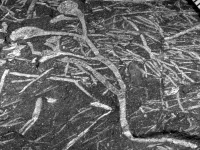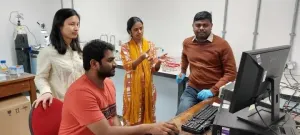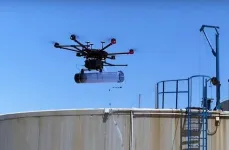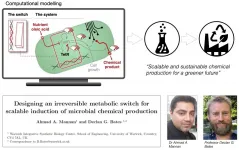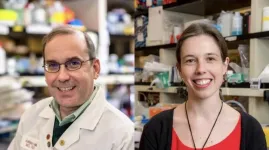The team first created tiny bubbles with a radius of a few thousandths of a millimetre by focusing an infrared laser pulse in water to create "cavitation" (a phenomenon in which small vapour-filled cavities, ie bubbles, form in a liquid). The researchers observed the expanding bubble with synchronized but carefully controlled delayed X-ray pulses. "In contrast to visible light, where refraction and scattering blur the image, X-ray imaging not only resolves the shape but also the density profile of the interior of both the bubble and the shockwave," explains Malte Vassholz, PhD student at the University of Göttingen and lead author of the publication. Vassholz goes on to say, "This enabled us to generate X-ray holograms of the tiny bubbles and record a large data stream with thousands of events which we then analyzed by a specially devised 'decoding algorithm' to obtain the density of the gas in the bubble and the shockwave around it." Thanks to the well-controlled time delay between the seeding laser pulse that created the effect and the X-ray pulse that measured it, the team could then record a 'movie' of the process.
The results of his experiment already challenge current scientific understanding and will help other scientists develop better models. Professor Tim Salditt, Professor of X-Ray Physics at the University of Göttingen, explains, "Even though water is the most important liquid on Earth, there is still much to learn about this mysterious and elusive substance. Thanks to the unique properties of the X-ray laser radiation generated at the European XFEL, and our new single shot holography method, we can now observe what really goes on in vapour and liquid water under extreme conditions."
This research technique provides insights for processes relevant in other applications: "Cavitation can be an undesirable effect in fluids in pumps or propellers for instance, but it can be harnessed for use in laser processing of materials or to modify chemical reactions," explains Dr Robert Mettin, an expert researching cavitation for many years at the Faculty of Physics, Göttingen University. "In laser surgery, shockwaves and compressed gases in tiny bubbles are created intentionally in tissue, by laser pulses," adds Salditt. "In the future, such processes could be 'filmed' in detail, using the methodology which we have developed, at a microscopic level and at high temporal resolution."
Original publication: Vassholz et al, Pump-probe X-ray holographic imaging of laser-induced cavitation bubbles with femtosecond FEL pulses, Nature Communications 2021. DoI: 10.1038/s41467-021-23664-1. Text also available at: https://www.nature.com/articles/s41467-021-23664-1
An animated explainer video on our website https://www.uni-goettingen.de/en/3240.html?id=6287 shows how the experiment was carried out by researchers at the University of Göttingen, Deutsches Elektronen-Synchroton (DESY) and the European X-Ray Free-Electron Laser (European XFEL). An infra-red laser beam is tightly focused into a water-filled container, igniting a plasma spark; the subsequent shock wave and cavitation bubble are imaged by an X-ray flash. From this, the density inside the bubble and the surrounding shock wave is computed.
Everyone is familiar with tiny gas bubbles gently rising up in sparkling water. But the bubbles that were created by intense focused lasers in this experiment were ten times smaller and contained water vapour at a pressure around a hundred thousand times higher. Under these conditions, the bubble expands at supersonic speed and pushes a shockwave, consisting of a spherical shell of highly compressed water, ahead of itself. Now the research team led by the University of Göttingen, together with the Deutsches Elektronen-Synchroton (DESY) and the European X-Ray Free-Electron Laser (European XFEL), has created such an event and then, with an innovative technique that they developed using holographic flash imaging and nanofocused X-ray laser pulses, captured data and images. The research was published in Nature Communications.
The team first created tiny bubbles with a radius of a few thousandths of a millimetre by focusing an infrared laser pulse in water to create "cavitation" (a phenomenon in which small vapour-filled cavities, ie bubbles, form in a liquid). The researchers observed the expanding bubble with synchronized but carefully controlled delayed X-ray pulses. "In contrast to visible light, where refraction and scattering blur the image, X-ray imaging not only resolves the shape but also the density profile of the interior of both the bubble and the shockwave," explains Malte Vassholz, PhD student at the University of Göttingen and lead author of the publication. Vassholz goes on to say, "This enabled us to generate X-ray holograms of the tiny bubbles and record a large data stream with thousands of events which we then analyzed by a specially devised 'decoding algorithm' to obtain the density of the gas in the bubble and the shockwave around it." Thanks to the well-controlled time delay between the seeding laser pulse that created the effect and the X-ray pulse that measured it, the team could then record a 'movie' of the process.
The results of his experiment already challenge current scientific understanding and will help other scientists develop better models. Professor Tim Salditt, Professor of X-Ray Physics at the University of Göttingen, explains, "Even though water is the most important liquid on Earth, there is still much to learn about this mysterious and elusive substance. Thanks to the unique properties of the X-ray laser radiation generated at the European XFEL, and our new single shot holography method, we can now observe what really goes on in vapour and liquid water under extreme conditions."
This research technique provides insights for processes relevant in other applications: "Cavitation can be an undesirable effect in fluids in pumps or propellers for instance, but it can be harnessed for use in laser processing of materials or to modify chemical reactions," explains Dr Robert Mettin, an expert researching cavitation for many years at the Faculty of Physics, Göttingen University. "In laser surgery, shockwaves and compressed gases in tiny bubbles are created intentionally in tissue, by laser pulses," adds Salditt. "In the future, such processes could be 'filmed' in detail, using the methodology which we have developed, at a microscopic level and at high temporal resolution."
INFORMATION:
Original publication: Vassholz et al, Pump-probe X-ray holographic imaging of laser-induced cavitation bubbles with femtosecond FEL pulses, Nature Communications 2021. DoI: 10.1038/s41467-021-23664-1. Text also available at: https://www.nature.com/articles/s41467-021-23664-1
An animated explainer video on our website https://www.uni-goettingen.de/en/3240.html?id=6287 shows how the experiment was carried out by researchers at the University of Göttingen, Deutsches Elektronen-Synchroton (DESY) and the European X-Ray Free-Electron Laser (European XFEL). An infra-red laser beam is tightly focused into a water-filled container, igniting a plasma spark; the subsequent shock wave and cavitation bubble are imaged by an X-ray flash. From this, the density inside the bubble and the surrounding shock wave is computed.
Contact:
Professor Tim Salditt
University of Göttingen
Institute for X-ray Physics
Friedrich-Hund-Platz 1, 37077 Göttingen
Tel: +49 (0)551 39-29918 / Secretary: +49 (0) 551 39 25556
Email: tsaldit@gwdg.de
http://www.roentgen.physik.uni-goettingen.de
Malte Vassholz
University of Göttingen
Institute for X-ray Physics
Friedrich-Hund-Platz 1, 37077 Göttingen, Germany
Tel: +49 (0)551 39-29428
mvassho@gwdg.de
Dr Robert Mettin
Third Institute of Physics - Biophysics
University of Göttingen
Friedrich-Hund-Platz 1, 37077 Göttingen, Germany
Tel: 49 (0)551 39-26933
Email: RMettin@gwdg.de
http://www.uni-goettingen.de/de/501414.html
Contact:
Professor Tim Salditt
University of Göttingen
Institute for X-ray Physics
Friedrich-Hund-Platz 1, 37077 Göttingen
Tel: +49 (0)551 39-29918 / Secretary: +49 (0) 551 39 25556
Email: tsaldit@gwdg.de
http://www.roentgen.physik.uni-goettingen.de
Malte Vassholz
University of Göttingen
Institute for X-ray Physics
Friedrich-Hund-Platz 1, 37077 Göttingen, Germany
Tel: +49 (0)551 39-29428
mvassho@gwdg.de
Dr Robert Mettin
Third Institute of Physics - Biophysics
University of Göttingen
Friedrich-Hund-Platz 1, 37077 Göttingen, Germany
Tel: 49 (0)551 39-26933
Email: RMettin@gwdg.de
http://www.uni-goettingen.de/de/501414.html
